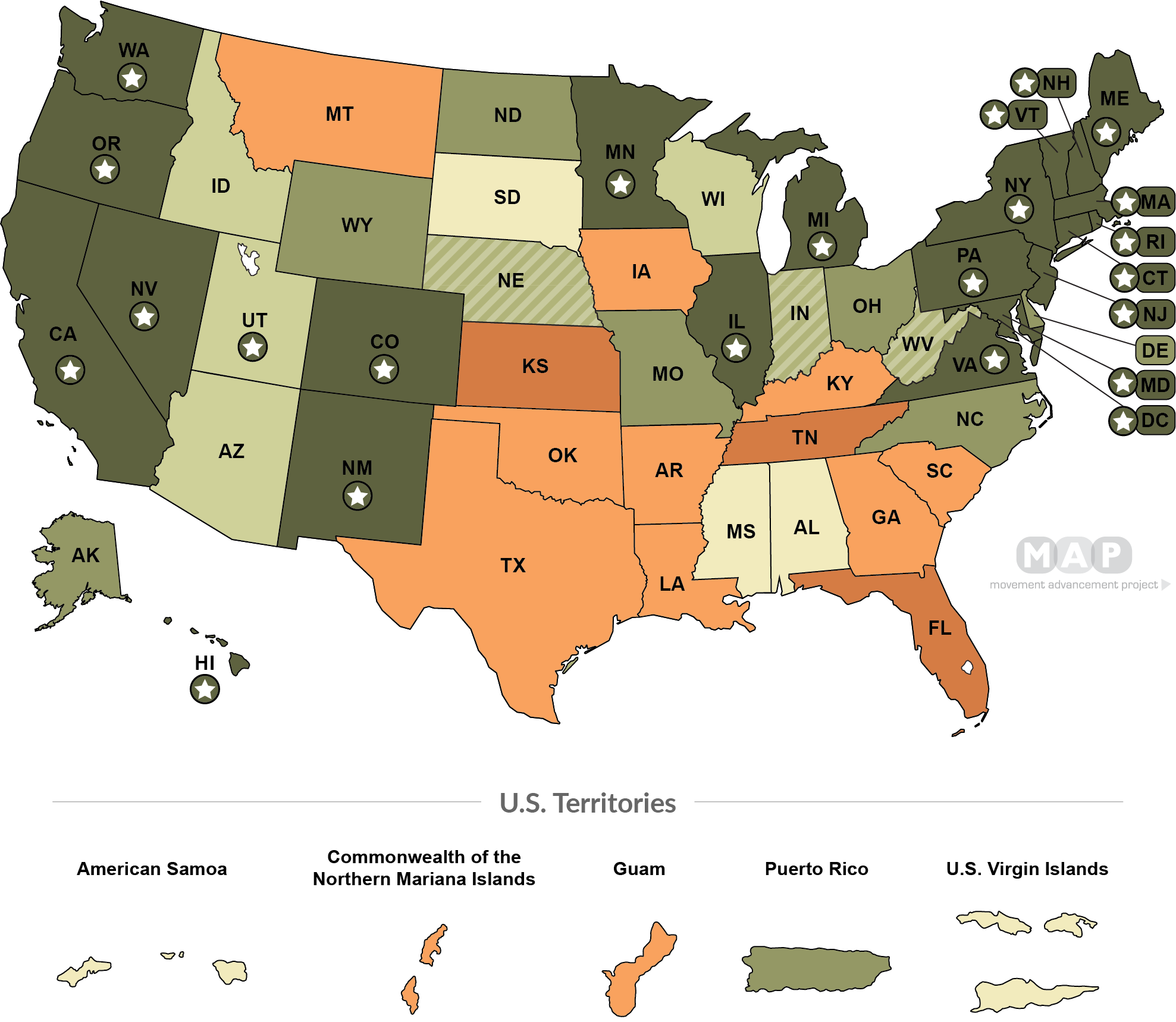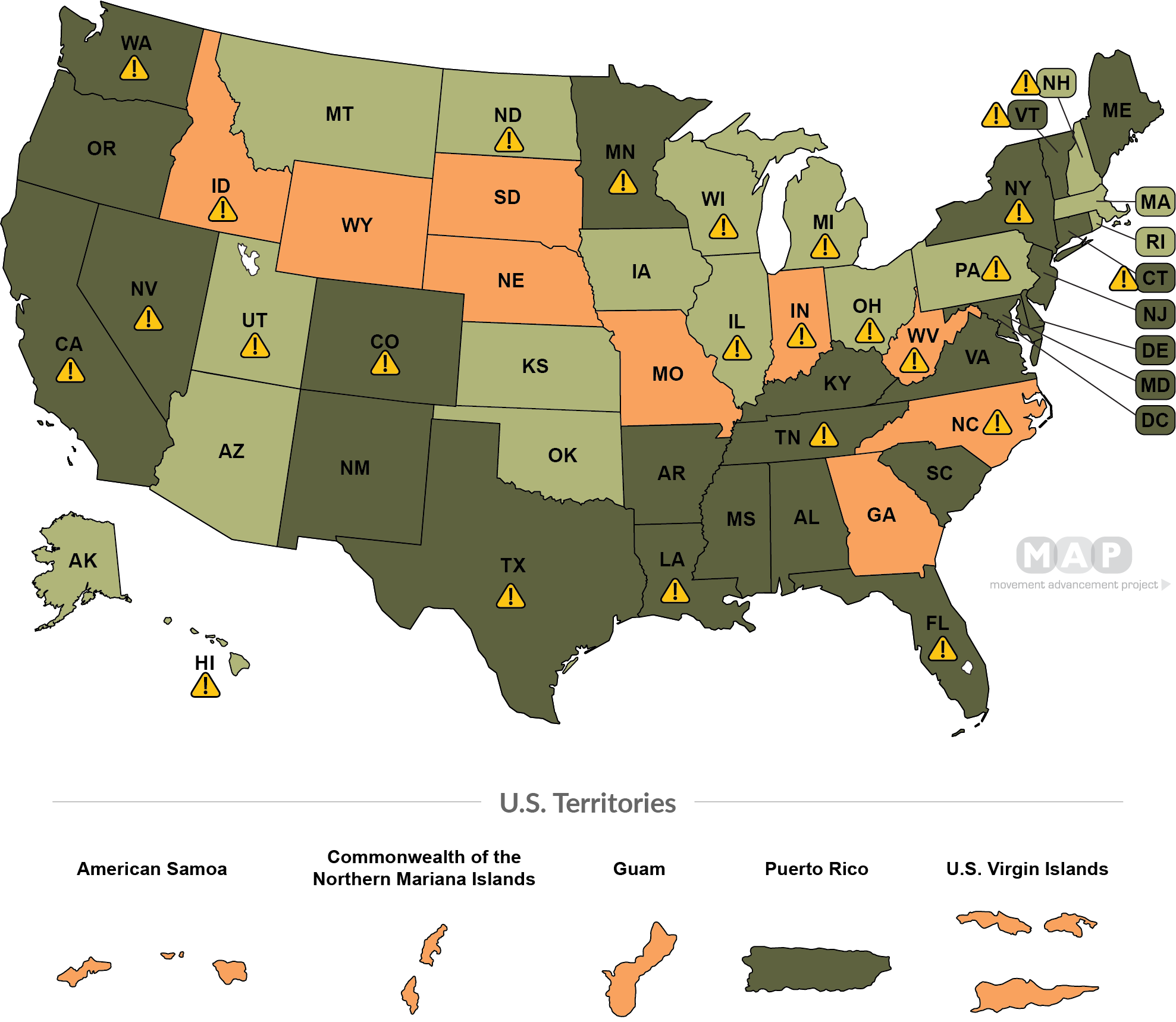Driver’s license policies govern the process by which a person can change the gender marker on their driver’s license. Many transgender people choose to update the gender marker on their identity documents so that it matches their gender identity. Accurate and consistent gender markers on identity documents help transgender people gain access to public spaces and resources, as well as dramatically reducing the risk that they will face violence, discrimination, or harassment. Additionally, states may allow individuals to identify as something other than male or female on their driver's licenses. The ease of the process to change gender markers is independent of how many gender options (i.e., male, female, nonbinary) are available.
However, many states have not yet modernized their policy or process, making it significantly challenging for transgender people to access identification that matches their gender identity and protects their safety. This map examines the variation in state policies regarding both the process of changing one's gender marker, as well as the gender marker options available in a given state. This map's categories were developed in conversation with the National Center for Transgender Equality (NCTE) and based on their driver's license process grading system, available
here.

-

State allows residents to mark M, F, or X on their driver's license
(22 states + D.C.)
-
State uses easy to understand form and does not require provider certification
(21 states + D.C.)
-
State uses easy to understand form and requires provider certification (accepted from wide range of professionals)
(6 states, 1 territory)
-
State uses easy to understand form and requires provider certification (accepted from limited range of professionals)
(3 states)
-
State has no form. No court order or proof of surgery required, but burdensome process requirements and/or provider certification required from limited range of professionals
(4 states)
-
State has unclear, unknown or unwritten policy regarding gender marker changes
(3 states, 2 territories)
-
State requires proof of surgery, court order, or amended birth certificate
(9 states, 2 territories)
-
State does not allow for updating the gender marker on driver's license
(4 states)
*NOTES (and click the orange button "Citations & More Information" beneath the map legend for more info about every state):- In Arkansas, a March 2024 proposed "emergency" rule immediately ended the state's 14+ year policy of allowing "X" options on driver's licenses and significantly altered the process for changing the gender marker (to either M or F). The new process only allows for a driver's license update if the person has also amended their birth certificate. However, Arkansas makes it extremely difficult to do so, requiring both a court order and "surgical procedure"--and the state also explicitly allows health insurers to refuse to cover transgender-related medical care. - In Florida, a January 2024 policy change banned gender marker changes on driver's licenses. While the agency's memo mentions potential criminal and/or civil penalties for transgender people having an ID that matches their gender identity, it is beyond the authority of the agency to unilaterally declare or reinterpret the state's criminal and/or civil statutes. MAP's resources will continue to be updated as events unfold in the state.- In Kansas, a July 2023 court order is preventing people from changing the gender on their driver's license at all, pending an ongoing lawsuit about a recently enacted state law defining sex in ways that enable discrimination against transgender people. This map will be updated as events unfold in the state.
The processes by which an individual can change the gender marker on their driver's license and/or birth certificate to accurately reflect their gender identity are governed by state laws and administrative policies and often include intrusive and outdated requirements, such as proof of sex reassignment surgery and court orders. According to the National Center for Transgender Equality, burdensome requirements and prohibitive costs prevent the majority of transgender individuals from obtaining accurate identity documents.
For more information, please see the National Center for Transgender Equality's Identity Documents Center.
Recommended citation:
Movement Advancement Project. "Equality Maps: Identity Document Laws and Policies." https://www.mapresearch.org/equality-maps/identity_document_laws. Accessed [day of access].
Percent of Transgender Population Covered by Laws
*Note: These percentages reflect estimates of the transgender population (ages 18+) living in the 50 states and the District of Columbia. Estimates of transgender people in the U.S. territories are not available, and so cannot be reflected here. Population estimates are from The Williams Institute.
51 % of transgender people (ages 18+) live in states that allow residents to mark M, F, or X on their driver's license
50 % of transgender people (ages 18+) live in states with an easy to understand form and no provider certification required
10 % of transgender people (ages 18+) live in states with an easy to understand form and provider certification requirements (accepted from wide range of professionals)
3 % of transgender people (ages 18+) live in states with an easy to understand form and provider certification requirements (accepted from limited range of professionals)
6 % of transgender people (ages 18+) live in states with no form; no court order or proof of surgery required, but burdensome process and/or provider certification requirements
2 % of transgender people (ages 18+) live in states with an unclear, unknown, or unwritten policy regarding the process of gender marker changes
12 % of transgender people (ages 18+) live in states that require proof of surgery, court order, and/or amended birth certificate to change gender marker
17 % of transgender people (ages 18+) live in states that do not allow for updating the gender marker on the driver’s license
Birth certificate laws govern the process by which a state changes (or refuses to change) a gender marker on a person’s birth certificate. Many transgender people choose to revise the gender marker on their identity documents so that it matches the gender they live every day. Accurate and consistent gender markers on identity documents helps transgender people gain access to public spaces and resources, as well as dramatically reducing the risk they will face violence, discrimination, or harassment. For more information, see here.

-

State allows residents to mark M, F, or X on their birth certificates
(15 states + D.C.)
-
State issues new birth certificate and does not require sex reassignment surgery nor court order in order to change gender marker
(25 states , 1 territory + D.C.)
-
State is unclear regarding medical requirements and/or may require a court order to change gender marker
(3 states, 1 territory)
-
State has unclear, unknown or unwritten policy regarding gender marker changes
(3 states, 2 territories)
-
State requires proof of sex reassignment surgery in order to change gender marker
(12 states, 1 territory)
-
State does not allow for amending the gender marker on the birth certificate
(7 states)
-

State bans the use of an X option on birth certificates
(3 states)
*NOTES (and click the "Citations & More Information" button below the map legend for more information on every state):
--As reported in July 2024, Florida is no longer processing gender marker changes on birth certificates. While the state has not publicly provided a new policy to this effect (as of Sept 2024), such changes continue to be denied. This map will be updated as more information becomes available.--Since 2014, Indiana has updated birth certificates with a court order. While numerous court rulings have affirmed that the state's courts have the authority to issue these orders, in 2022, two separate appellate court rulings
argued that state courts lack that authority, leaving a split. In May 2023, the state Supreme Court refused to hear those cases, leaving the question unresolved. This means that, while some judges continue to issue gender marker changes in the state, others may choose not to, leading to potentially unclear and inconsistent experiences for transgender Hoosiers. For assistance with name or gender marker changes in Indiana, see also Indiana Legal Services' LGBT Project.The processes by which an individual can change the gender marker on their driver's license and/or birth certificate to accurately reflect their gender identity are governed by state laws and administrative policies and often include intrusive and outdated requirements, such as proof of sex reassignment surgery and court orders. According to the National Center for Transgender Equality, burdensome requirements and prohibitive costs prevent the majority of transgender individuals from obtaining accurate identity documents.
For more information, please see the National Center for Transgender Equality's Identity Documents Center.
Recommended citation:
Movement Advancement Project. [Year of access]. "Equality Maps: Identity Document Laws and Policies." https://www.mapresearch.org/equality-maps/identity_document_laws. Accessed [day of access].
Percent of Transgender Population Covered by Laws
*Note: These percentages reflect estimates of the transgender population (ages 18+) living in the 50 states and the District of Columbia. Estimates of transgender people in the U.S. territories are not available, and so cannot be reflected here. Population estimates are from The Williams Institute.
37 % of transgender people (ages 18+) live in states that allow residents to mark M, F, or X on their birth certificates
57 % of transgender people (ages 18+) live in states that issue new birth certificates and do not require sex reassignment surgery nor court order in order to change gender marker
4 % of transgender people (ages 18+) live in states that are unclear regarding medical requirements and/or may require a court order to change gender marker
4 % of transgender people (ages 18+) live in states have unclear, unknown or unwritten policy regarding gender marker changes
16 % of transgender people (ages 18+) live in states require proof of sex reassignment surgery in order to change gender marker
19 % of transgender people (ages 18+) live in states that do not allow for amending the gender marker on the birth certificate
Many transgender people change their legal name to better reflect their gender identity. While state laws generally allow individuals to change their legal name for any non-criminal purpose, many states still have outdated and burdensome requirements that create substantial barriers to achieving a legal name change. One of the most common and problematic requirements is that a person must publicly post or publish their legal name change request, often in a local newspaper. This not only poses a financial obstacle (as the publication typically must be paid for), but also puts the person at risk of potential harm, harassment, or discrimination. Another significant barrier is that many states have additional rules and restrictions on name changes for people who have a criminal record. These aspects of the name change process are reflected in the map below. For more information, please see the National Center for Transgender Equality's Identity Documents Center.

-
State law does not require publication of name change announcement
(25 states , 1 territory + D.C.)
-
State law has unclear publication requirement, or requires publication but allows individual court discretion and/or broad option to waive requirement
(16 states)
-
State law requires publication of name change announcement
(9 states, 4 territories)
-

State law includes additional restrictions and/or requirements for individuals with a criminal record
(24 states)
Percent of Transgender Population Covered by Laws
*Note: These percentages reflect estimates of the transgender population (ages 18+) living in the 50 states and the District of Columbia. Estimates of transgender people in the U.S. territories are not available, and so cannot be reflected here. Population estimates are from The Williams Institute.
61 % of transgender people (ages 18+) live in states that do not require publication of name change announcement
26 % of transgender people (ages 18+) live in states with unclear requirements, individual court discretion, or broad waiver options for public announcement of a name change
13 % of transgender people (ages 18+) live in states that require publication of name change announcement
66 % of transgender people (ages 18+) live in states with additional restrictions and/or requirements for individuals with a criminal record







